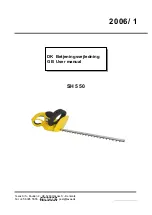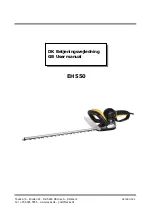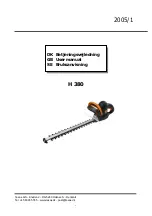
3.
Wash the filter in detergent and water (Fig. 31). Rinse the
filter thoroughly and allow it to dry.
4.
Apply enough clean SAE 30 motor oil to lightly coat the
filter (Fig. 32).
5.
Squeeze the filter to spread and remove excess oil (Fig. 33).
6.
Replace the filter (Fig. 34).
NOTE:
If the unit is operated without the air filter, you will
VOID the warranty.
7.
Reinstall the air filter cover. Position the slots on the top of
the air filter cover onto the tabs at the top of the back plate
(Fig. 30).
8.
Swing the cover down until the tab on the air filter backplate snaps into place in the slot on the air
filter cover (Fig. 30).
Fig. 33
CARBURETOR ADJUSTMENT
The idle speed of the engine is adjustable. An idle adjustment screw is between the air filter cover and the
engine starter housing (Fig. 35).
NOTE:
Careless adjustments can seriously damage your unit. An authorized service dealer should
make carburetor adjustments.
Check Fuel
Old fuel is usually the reason for improper unit performance. Drain and refill the tank with fresh fuel prior
to making any adjustments. Refer to Oil and Fuel Information.
Clean Air Filter
The condition of the air filter is important to the operation of the unit. A dirty air filter will restrict air flow.
This is often mistaken for an out of adjustment carburetor. Check the condition of the air filter before
adjusting the idle speed screw. Refer to Air Filter Maintenance.
Adjust Idle Speed Screw
If, after checking the fuel and cleaning the air filter, the engine still
will not idle, adjust the idle speed screw as follows:
1.
Start the engine and let it run at a high idle for a minute to
warm up. Refer to Starting/Stopping Instructions.
2.
Release the throttle trigger and let the engine idle. If the
engine stops, insert a small phillips in between the Air Filter Cover and the Engine Cover (Fig. 35).
Turn the idle speed screw in, clockwise, 1/8 of a turn at a time (as needed) until the engine idles
smoothly.
NOTE:
The cutting attachment should not rotate when the engine idles.
3.
If the cutting attachment rotates when the engine idles, turn the idle speed screw
counterclockwise 1/8 of a turn at a time (as needed), to reduce idle speed.
Checking the fuel, cleaning the air filter, and adjusting the idle speed should solve most engine problems.
If not and all of the following are true:
•
the engine will not idle
•
the engine hesitates or stalls on acceleration
•
there is a loss of engine power
Have the carburetor adjusted by an authorized service dealer.
ROCKER ARM CLEARANCE
This requires disassembly of the engine. If you feel unsure or
unqualified to perform this, take the unit to an authorized service
center.
NOTE:
Inspect the valve to rocker arm clearance with a
feeler gauge after the first 10 hours of operation and
every 25 hours of operation.
•
The engine must be cold when checking or adjusting the valve
clearance.
•
This task should be performed inside, in a clean, dust free area.
1.
Remove the six (6) screws on the back of the engine cover
with a Flat-head or T-25 Torx screwdriver (Fig. 36).
2.
Disconnect the spark plug wire.
3.
Clean dirt from around the spark plug. Remove the spark
plug from the cylinder head by turning a 5/8 in. socket
counterclockwise.
4.
Remove the engine cover (Fig. 36).
5.
Clean dirt from around the rocker arm cover. Remove the
screw holding the rocker arm cover with a large flat blade
screwdriver or Torx T-25 bit (Fig. 37). Remove the rocker
arm cover and gasket.
6
MAINTENANCE AND REPAIR INSTRUCTIONS
CHECKING THE OIL LEVEL
The importance of checking and maintaining the proper oil level in the
crankcase cannot be overemphasized. Check oil before each use:
1.
Stop the engine and allow oil to drain into the crankcase.
2.
Place the engine on a flat, level surface with the cutting
head shield hanging off a work bench or table to get a
proper oil level reading (Fig. 24).
3.
Keep dirt, grass clippings and other debris out of the engine.
Clean the area around the dipstick before removing it.
4.
Remove the oil fill plug.
5.
Look into the oil fill hole, use a flashlight if needed. The oil
should be just touching the inner most thread (Fig. 25).
6.
If the oil level is not touching the inner most thread on the
oil fill hole, add a small amount of oil to the oil fill hole and
recheck (Fig. 25). Repeat this procedure until the oil level
reaches the inner most thread on the oil fill hole.
NOTE:
Do not overfill the unit.
NOTE:
Make sure the O-ring is in place on the oil fill plug
when checking and changing the oil (Fig. 26).
CHANGING THE OIL
For a new engine, change the oil after the first 10 hours of
operation. Change the oil while the engine is still warm. The oil will
flow freely and carry away more impurities.
1.
Unplug spark plug boot to prevent accidental starting.
2.
Remove the oil fill plug.
3.
Pour the oil out of the oil fill hole and into a container by
tipping the unit to a vertical position (Fig. 27). Allow ample
time for complete drainage.
4.
Wipe up any oil residue on the unit and clean up any oil that
may have spilled. Dispose of the oil according to Federal,
State and local regulations.
5.
Refill the crankcase with 3.04 fluid ounce (90 ml) of SAE 30
SF, SG, SH oil.
NOTE:
Use the bottle and spout saved from initial use to measure
the correct amount of oil. The top of the label on the bottle
measures approximately 3.04 ounces (90 ml) (Fig. 29).
Check the level, See Checking the Oil Level. If the level is
low, add a small amount of oil and recheck. Do not overfill
(Fig. 25).
6.
Replace the oil fill plug.
7.
Reconnect the spark plug boot.
AIR FILTER MAINTENANCE
Cleaning the Air Filter
Clean and re-oil the air filter every 10 hours of operation. It is an
important item to maintain. Failure to maintain your air filter
properly can result in poor performance or can cause permanent
damage to your engine.
1.
Open the air filter cover. Push the tab on the under side of
the cover inward. Then pull the air filter cover out and up.
(Fig. 30).
2.
Remove the air filter (Fig. 34).
Fig. 20
Fig. 21
Fig. 23
Fig. 22
Bump Cap
Inner
Reel
Spring
Outer Spool
PRESS
UP
Tab
WARNING:
To prevent extensive engine wear
and damage to the unit, always maintain the
proper oil level in the crankcase. Never operate
the unit with a low oil level.
CAUTION:
Wear gloves to prevent injury
when handling the unit.
WARNING:
To avoid serious personal injury,
always turn the unit off and allow it to cool
before you clean or service it.
Fig. 25
Fig. 24
Fig. 26
Max Oil Fill Line
Oil Fill Plug
O-Ring
Fig. 28
Fig. 27
Fig. 29
Fig. 31
Fig. 30
Fig. 32
Air Filter Cover
Air Filter
Tab
Oil Fill Hole
Fill Line
Fig. 34
Tabs
Back Plate
Locking Tab
Air Filter
WARNING:
To avoid serious personal injury,
always turn the unit off and allow it to cool
before you clean or service it.
WARNING:
The cutting attachment may spin
during idle speed adjustments. Wear protective
clothing and observe all safety instructions to
prevent serious personal injury.
Fig. 35
Idle Adjustment Screw
Fig. 36
View Of The Rear Engine Cover
Fig. 37
Rocker Arm Cover
Fig. 38
Adjustment
Nuts
Intake
Exhaust
Rocker
Arms
Spark Plug
Hole
Screws
Screws
NOTE:
When placing the inner reel back into the outer spool, make sure the side with the L is facing
up towards the bump cap.
5.
Replace the bump cap by aligning the tabs of the bump cap with the tab lock windows of the outer
spool and press down firmly until both tabs snap back into place. (Fig. 23)
To install new line, please
refer to the Line Installation section.







































